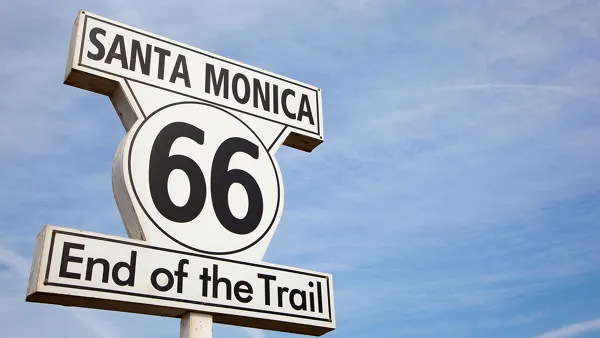Reporter Ben Adler travels to Leesburg, VA without a car and reports on the difficulties he experiences getting around. In comparison, Ben walks with ease around Kentlands, a New Urbanist development in Maryland.
"In October, I did the unthinkable and went to stay in Leesburg, where my grandmother lives, without a car. After taking the commuter bus to Leesburg from Washington, D.C., I arrived in a massive gravel parking lot. Everyone jumped into a car and drove home, except for one or two bicyclists and a few people waiting to be picked up. For the car-less, these commuter buses are the only way into or out of Leesburg, save for one "reverse commuter" bus that goes to the nearest Metro station, roughly 40 minutes away. No trains stop here, no Greyhound station is in sight, and no buses come on the weekends. A cab to the Metro costs at least $60. Walking? Forget about it. The sidewalks are narrow and poorly lit, and cars whiz by without a buffer lane of parked cars to slow them down. It's enough to make pedestrians feel downright unsafe.
Even as Leesburg notionally committed to a more responsible land-use pattern in its 2005 town plan, it continues to zone undeveloped land at low densities. The standard in Leesburg is four units to the acre, although it is sometimes lower -- in contrast with a typical city block, which would have approximately 25 buildings per acre and possibly far more units if they were subdivided into apartments. Yet Leesburg actively discourages developers from building more sensibly. That is because the Town Council fears that dense plans will bring costly infrastructure needs, such as sewers, and that great suburban boogeyman, traffic. In 2007, one developer bought the right to build a mix of town homes and detached houses on an undeveloped property by paying to expand the arterial road that will serve it from two lanes to four. So to build denser in Leesburg, you need to give the town exactly more of what it does not need: wider roads."
FULL STORY: A Tale of Two Exurbs

Analysis: Cybertruck Fatality Rate Far Exceeds That of Ford Pinto
The Tesla Cybertruck was recalled seven times last year.

National Parks Layoffs Will Cause Communities to Lose Billions
Thousands of essential park workers were laid off this week, just before the busy spring break season.

Retro-silient?: America’s First “Eco-burb,” The Woodlands Turns 50
A master-planned community north of Houston offers lessons on green infrastructure and resilient design, but falls short of its founder’s lofty affordability and walkability goals.

Test News Post 1
This is a summary

Analysis: Cybertruck Fatality Rate Far Exceeds That of Ford Pinto
The Tesla Cybertruck was recalled seven times last year.

Test News Headline 46
Test for the image on the front page.
Urban Design for Planners 1: Software Tools
This six-course series explores essential urban design concepts using open source software and equips planners with the tools they need to participate fully in the urban design process.
Planning for Universal Design
Learn the tools for implementing Universal Design in planning regulations.
EMC Planning Group, Inc.
Planetizen
Planetizen
Mpact (formerly Rail~Volution)
Great Falls Development Authority, Inc.
HUDs Office of Policy Development and Research
NYU Wagner Graduate School of Public Service




























